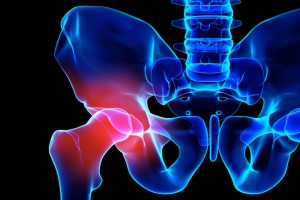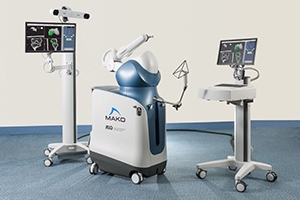When considering hip replacement surgery, one of the things you need to think about is recovery. How long is the average robotic hip replacement recovery time? What are the common post-surgery side effects that patients experience? To answer these questions, we'll delve into what robotic hip replacement is and discuss what patients can expect during their recovery period.
What Is Robotic Hip Replacement?
Robotic hip replacement surgery is similar to standard hip replacement surgery, except it uses robotics to enhance the surgeon's precision and accuracy. The procedure involves:
- Cutting the femur.
- Removing the cartilage from the acetabulum.
- Shaping the bone in a hemispherical shape to fit in the titanium acetabular cup.
Surgeons also use drilling and cutting tools for hip surgery, making accuracy paramount.
One of the primary advantages of robotic hip replacement is it uses 3D imaging to recreate a precise model of the patient’s hip joint. Getting this visual of the site reduces inaccuracies by an estimated 94 percent which, in turn, increases the chances of a successful operation and smooth recovery.
How Long Does Robotic Hip Replacement Surgery Take?
At American Hip Institute, one of the most common questions we receive is how long does robotic hip replacement surgery take? It takes 20-30 minutes longer than the conventional hip replacement procedure and can last for over an hour total. This is because surgeons take more time to prepare, setting pins in the surgical site and ensuring that correct data is provided to the robot assisting the procedure.
Surgeons must achieve the correct alignment for the prosthesis implanted in the hip joint. Doing so lowers the risk of complications such as infection, dislocation, loosening of the implant, and replacement rejection. More importantly, a flawless execution increases the chances of a smooth and quick recovery.
Robotic Hip Replacement Recovery Time
More than knowing how long robotic hip placement surgery takes, patients are usually curious about the robotic hip replacement recovery time. The average recovery period for this procedure is three to six months. This is because no two people recover in exactly the same manner. Some patients can do most of their usual daily activities as early as three months post-surgery. Others, however, take a longer time to heal. Below is an estimated timeline for robotic hip replacement recovery time.
- Same-day or one day after surgery - Some patients are well enough to go home on the day of the surgery, but most will consent to stay at least one whole day in the hospital for post-surgery observation.
- Week 1 post-surgery - If the surgical site is healing well and the patient doesn’t feel any pain or discomfort when moving, they can practice walking with a mobility aid, like a cane, crutches, or a walker.
- Weeks 2 to 3 - It is normal to experience numbness in the surgical area and some swelling and redness. Complications usually emerge at this period, so patients and their guardians must be vigilant. Shortness of breath, chest pain, and high fever can be signs of infection, for example, and must be raised to the patient's physician immediately. To ensure a safe and timely recovery, patients may enroll in a physical rehabilitation center.
- Weeks 3 to 6 - Patients who follow the recommended post-surgery care and do not experience any complications after their robotic hip replacement surgery may be able to walk unassisted for at least 21 days after. They can also dial down the pain medication; some can be completely off by week four. This is also when patients are encouraged to do more physical activities to help their bodies return to full mobility.
- Weeks 12 to 16 (three to four months after surgery) - Most hip replacement patients are finally fully recovered at this time. They can walk unassisted, have zero pain, and engage in regular activities without restriction. However, it is also customary to occasionally feel some stiffness and soreness on the hips, especially after a day of exertions.
The surgical site should already look and feel normal one year after a robotic hip replacement procedure. Although there can still be some soreness and stiffness, it should not hinder the patient's mobility or cause much pain. However, if the pain and discomfort persist, patients should consult their surgeon and attending physician whether a follow-up treatment or rehab would be necessary.
Seek Robotic Hip Replacement from Orthopedic Specialists You Can Trust
A robot-assisted hip replacement procedure theoretically offers better outcomes, such as fewer incisions and minimal tissue damage (both of which promote faster recovery). However, its success rate is highly dependent on the medical professional that carries out the procedure. To get optimal results and avoid complications that can prolong recovery time, seek out an experienced robotic hip replacement specialist to do the procedure.
American Hip Institute's orthopedic specialists and surgeons are highly qualified to perform a robotic hip replacement. In fact, American Hip Institute orthopedic specialists and surgeons is the only institution in the nation that focuses specifically on hip surgery. Being the first in the nation to perform outpatient robotic hip replacement and with over 10,000 hip surgeries performed over the last decade, you can be assured that our patients experience the best possible outcomes. We have several state-of-the-art clinics providing minimally-invasive treatments to address hip pain and injuries. In addition, American Hip Institute is known for developing surgical techniques that use cutting-edge medical technology. Besides robotic hip replacement, our surgeons perform hip arthroscopy, hip resurfacing, non-surgical hip procedures, and various techniques on conventional hip replacement
If this is a procedure you are considering for yourself or a loved one, call us at (833-872-4477) or schedule an appointment online.




